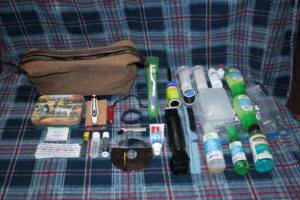You can view the follow up posts in the Satellites area of my blog.
I originally wrote this piece for Core Concept Podcast. While I hope to resurrect the podcast, I needed to gather my thoughts on what I know as I work towards my goal of making contacts via the ham birds. I decided to attempt contact via the birds after the ARRL Field Day 2015.
Please know that this is not a complete, working guide to making contacts via Ham Radio enabled satellites. These are my notes on the subject, a goal which I’ve been unable to complete yet. I needed to make notes of what I’ve found and learned so far. I figured that I may as well make them public for all to see in the hopes that someone will find them useful.
Equipment
Antenna
The equipment needed is pretty simple. Youtube has videos showing people making contact with an HT turned sideways. However, contact is made easier with a yagi antenna which focuses where your radio transmissions will be sent or received. I elected to purchase an Arrow Antenna but plans for tape measure yagis and beam yagis that you could make are available online. Ham birds usually have a 2m uplink frequency and a 70cm downlink frequency. Sometimes its inverted however, so you would want to make sure that your yagis tuned for both.
Radio(s)
It is often advised to use a second radio so hear whether or not you are coming through the satellite. Otherwise, enabling dual watch on your baofeng should be sufficient. So I can know if I’m making it through, I ordered a Baofeng BF-F8HP to use. Having a second radio will also give me a backup unit for my shack. Another advantage is that the BF-F8HP transmits with 8 watts of power instead of the 4 watts the Baofeng UV5R has, so the F8HP should expand my range, if even for just a touch.
Documentation
Another thing that is noted it it would be worth recording your session so that you can make sure you have copied your QSOs correctly. I will use my laptop and my Blue Snowball microphone to achieve this.
Prepping to Make Contact
Finding Satellites to Contact
If you’re using a baofeng HT, you’re limited to FM birds only. KD0HKD has a great page listing a number of birds equiped with FM repeaters. However, most of his documentation links for the satellites have gone dead, lost to the passage of time on the internet. That’s okay, because some of Amsat’s own links are no better.
I was advised to pick two satellites to work on a regular basis. I was going to try to work SO-50 and the ISS but, alas, the ISS Fan club reports the FM repeater has been down for quite awhile now. So, I’ll stick with trying to work SO-50 and wait for when Fox-1A is operational.
Getting your gridsquare
To make contacts via a satellite, you’ll need to know where to point your yagi. Your gridsquare will give satellite tracking software the ability to determine where a satellite will rise in relation to your location. Also, when doing an exchange over a satellite, one of the pieces of information you’ll need to trade is your gridsquare.
You can calculate your grid square using the awesome Grid Square Calculator from Levine Central which allows you to enter your call sign to calculate your grid square representing your location on the globe. QRZ.com provides one as well, but it is more complicated to use.
Your elevation can be a little hard to find, but the wikipedia page had the elevation for my home town so I used that (and suggest you do to). Satellite trackers need this information as well.
Finding Satellites
There are a few different ways to this. You can use one or more of the following three resources:
- The Amsat Satellite Tracker. Very confusing, will only give a list of passes and headings. Will only show the passes for a single satellite. Shows pass times in UTC, so you will have to convert them to your local time zone or it will be useless.
- Heavens Above android app. Has a nice “live sky” plotting ability. I don’t think it was designed with Ham radio enthusiasts in mind. Can pull your location from GPS.
- GPredict. Probably the best option in my opinion. Not very user friendly, but provides a wealth of information once you understand how the program flows. And there is actual documentation (so far).
On both the AmSat Satellite tracker and GPredict you will need enter your grid square, elevation. I think GPredict is the best option currently.
This is the point where I haven’t been able to translate technical knowledge into physical experience. So everything is abit fuzzy from here on out.
Go outside, and using either a lensatic or baseplate compass figure out the points on the horizon where the satellite will come up, the mid point of its travel, and the point on the horizon where it will descend. Remember to account for magnetic declination.
Connect your radios to the arrow antenna and open the squelch on your receiving unit. Coordinating with the times and azimuth points that GPredict provides, trace the path of the satellite. When you cross the broadcast path of your chosen satellite the static will fade from your reception. You may also hear the call signs and gridsquares of other sat users.
If you can’t find your satellite, Amsat has a status page that other hams can report if they have been able to use a satellite. It may be worth checking and seeing if others have heard from the bird recently.
Additional resources
- The AmSat Fox Satellite Operating Guide
- Amsat’s Introduction to Satellite Operations.
- AMSAT Live OSCAR Satellite Status Page. Other hams report ther contacts with various satellites.

